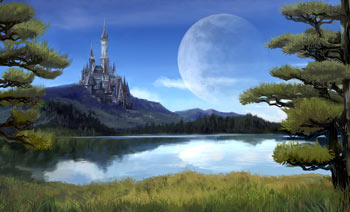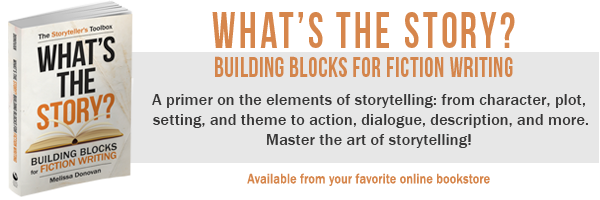Today’s post includes excerpts from What’s the Story? Building Blocks for Fiction Writing, chapter three: “Setting.” Enjoy!
Setting may not seem as critical to a story as character or plot, yet it is a core element of storytelling and for good reason. The setting of a story helps us understand where and when it takes place, which gives the story context. If the audience doesn’t have a sense of setting, they’ll feel lost and confused (sometimes that might be the author’s intent).
The Setting of a Story
A setting can be big or small. It can be a made-up world—a massive galaxy with multiple star systems and inhabited planets—or it can be a single room—four walls and a ceiling.
Settings can offer opportunities or present limitations for the characters. For example, when an apocalyptic event occurs, characters in a big city loot stores and warehouses, but food runs out fast and eventually people head for the hills. If the story is set in the farmlands, characters might not face an immediate food shortage. In fact, their biggest challenge might come later, when the city folk show up and attempt to hijack their crops. The setting of the story therefore drives the action, even if only peripherally.
Some settings provide conflict for a story. A story about a natural disaster, such as a tornado, must take place in a region where tornadoes are likely to strike. An author might choose a setting because it offers certain types of conflict for the characters. In the earlier apocalyptic example, an author might want to tell a story with looting and fighting and will therefore set the story in a metropolitan area. Other times, a setting is chosen at random but affects the course of the story nonetheless. For example, if a story is set in the mountains, when an emergency arises, it will likely take a lot longer for emergency services to arrive than if the story is set in the suburbs.
Tone and mood are also affected by a story’s setting. Consider a story set during the summer at a bright, sunny beach resort versus a story set during a dark, stormy winter at an old, abandoned Victorian mansion.
It’s All About the Setting
Some stories are all about the setting, meaning they’re quite literally about a particular time and place, even more than they’re about the characters or plot. Many historical novels give readers the experience of what it was like to live during a different time and place. Science-fiction and fantasy stories do the same but are based on imaginings or forecasts rather than on historical research.
Some settings function as little more than backdrops—although even a backdrop is critical. These settings may require very little work on a storyteller’s part (because they’re based on the contemporary real world) compared to settings that involve elaborate research or world building. Some settings are so seamlessly integrated into a story that we don’t even notice them. Others are so distinct and active that they function as characters within a story.
The Harry Potter books are rich with many magical settings, but Hogwarts, the school for wizards, often feels more like a character than a location. It’s a setting that feels alive; the characters interact with it and develop relationships with it. Setting as character is not limited to fantasy, science fiction, or horror. The television show Sex and the City is often hailed for making New York City the fifth character in the ensemble, and the island on the television show Lost was very much a character in the series.
It can be exciting for readers to discover a place they’re familiar with in a fictional story. Michael Connelly’s Harry Bosch novels often take readers through streets, past parks, and into real neighborhoods throughout Los Angeles. This is especially effective in big, coastal cities where a lot of readers may live or have visited.
Establishing the Setting of a Story
Settings are primarily established through description, action, and dialogue. Description is the simplest and most common way to relay a setting to a reader. But some readers will nod off if forced to sludge through pages (or even paragraphs) of description. Modern audiences like to get to the action and dialogue—they want to know what’s happening.
While paragraphs of description can establish a setting, action and dialogue can also be used to bring readers into a story world. Characters interact with the world around them, and they talk about it, which means setting can be incorporated into action and dialogue, as long as it’s natural to the story.
For example, instead of using description to explain the furnishings in a room, the characters can sit in plush velvet chairs or lean on rickety tables. One character might make a remark about a Picasso painting that’s hanging on the wall; another might admire the white linen draperies. If a character asks another character to go to the movies, we know the story is set in the twentieth century or later. When those characters watch a hologram, we know it’s set in the future.
Tips for Designing a Vivid Setting
- It’s all in the details. Details make a setting pop. Climate, geography, architecture, and culture make a setting realistic.
- Use a model. When creating a made-up setting, use a real location as a model, but let your imagination reshape the location, turning it into a new world. If possible, use your city or a nearby town as a model; this gives you easy access.
- When using a real location as a setting (or a model), conduct as much research as you can. Try to visit the location. Talk to locals, and peruse images and videos of the location online. Read books and watch movies about it.
- The time in which a story takes place is a major component of the setting. Over time, everything changes from the customs to the technology. Double-check your facts if you’re writing historical fiction, and use history as a trajectory when you’re writing about the future.
- Changing settings. Your story may take place in multiple settings. Move your story through time and space with smooth transitions. Use markers to let readers know where and when each scene is taking place.
- Setting as character. Is the setting vivid enough to function as a character within the story? Do the characters talk about it frequently? Does it have an especially big influence on their lives or the story? Could this story take place in any other location?
- Establishing the setting. Although large blocks of description about the setting are sometimes necessary, try to reveal details about the setting through action and dialogue. Avoid constantly stating the time or date. Drop clues, such as a setting sun or a snowy field, which establish the setting clearly but subtly.
- Props are the everyday items that characters encounter in a story’s setting. From swords and petticoats to microchips and hovercars, the props in a story often play a big role in bringing the setting to life in the reader’s mind, especially in speculative fiction.
- World building. If you’re building a world from scratch, keep the facts and details consistent. Readers will notice if the rules of the world are incongruous. If you’re writing an epic story or a series, keep track of the details of your world in a story bible.
To learn more about developing the setting of a story, pick up a copy of What’s the Story? Building Blocks for Fiction Writing.






I like the step by step instruction and hints
Thanks! I’m glad you liked them.